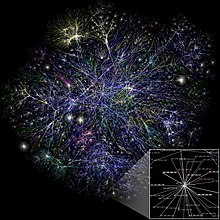Artificial neural network/Network


Networks of Neurons
editThe concept of artificial neural networks the neurons can be considered as processing units (=neurons) that get input values and produce output values. The output can be considered as a message send from one neuron to other neurons. The neurons can communicate if the are connected. If we connect as set of artificial neurons with each other a network is created. The structure of the network (decomposition in layers, input layer, output layer, hidden layer, ...) is called network topology.
Network of Layers
editThe neurons are typically organized into multiple layers, especially in deep learning. Neurons of one layer connect only to neurons of the immediately preceding and immediately following layers. The layer that receives external data is the input layer. The layer that produces the ultimate result is the output layer. In between them are zero or more hidden layers. Single layer and unlayered networks are also used. Between two layers, multiple connection patterns are possible. They can be 'fully connected', with every neuron in one layer connecting to every neuron in the next layer. They can be pooling, where a group of neurons in one layer connect to a single neuron in the next layer, thereby reducing the number of neurons in that layer.[1] Neurons with only such connections form a directed acyclic graph and are known as feedforward networks.[2] Alternatively, networks that allow connections between neurons in the same or previous layers are known as recurrent networks.[3]
Learning Activities
edit- Analyze if and how the human brain is organized in layers. Consider the visual cortex of the brain and the image processing starting from light on the retina towards the visual cortex in brain (V1,V2,V3,V4).
- Distributed processing applied on visual cortex describes the concept delegation of tasks to different areas of the brain. Identify the areas in the brain that are responsible to color detection, movement detection, edge detection, ...). How can we learn from the approach in biological neural networks (BNN) and transfer that to artificial neural networks.
See also
editReferences
edit- ↑ Ciresan, Dan; Ueli Meier; Jonathan Masci; Luca M. Gambardella; Jurgen Schmidhuber (2011). "Flexible, High Performance Convolutional Neural Networks for Image Classification". Proceedings of the Twenty-Second International Joint Conference on Artificial Intelligence-Volume Volume Two 2: 1237–1242. Archived from the original on 2022-04-05. https://people.idsia.ch/~juergen/ijcai2011.pdf. Retrieved 7 July 2022.
- ↑ Zell, Andreas (1994). Simulation Neuronaler Netze (in de) (1st ed.). Addison-Wesley. p. 73. ISBN 3-89319-554-8.
- ↑ Miljanovic, Milos (February–March 2012). "Comparative analysis of Recurrent and Finite Impulse Response Neural Networks in Time Series Prediction". Indian Journal of Computer and Engineering 3 (1). http://www.ijcse.com/docs/INDJCSE12-03-01-028.pdf.